Research Proposal: VPN Implementation in University Wireless Network
VerifiedAdded on 2019/09/20
|10
|2990
|176
Report
AI Summary
This research proposal explores the implementation of a Virtual Private Network (VPN) within a university campus environment, leveraging the existing wireless network infrastructure. The study aims to compare different hardware and operating system models to determine the most efficient technology for VPN implementation, focusing on minimizing memory and CPU usage. The research investigates the benefits of VPNs, including secure communication and data sharing, while also addressing security concerns and potential vulnerabilities. A thorough literature review examines existing research on VPN technology, protocols like IPsec, L2TP, PPTP, and SSL, and their applications in wireless networks. The research methodology employs a deductive approach, utilizing questionnaires, structured interviews, and statistical analysis to gather and evaluate data. The study also addresses issues of access and ethics, highlighting the role of VPNs in securing access to restricted resources. The primary data will be gathered through questionnaires and structured interviews, while secondary data will be obtained from organizational performance metrics, papers, and articles. The research aims to provide insights into the effective and secure deployment of VPNs in a campus setting.
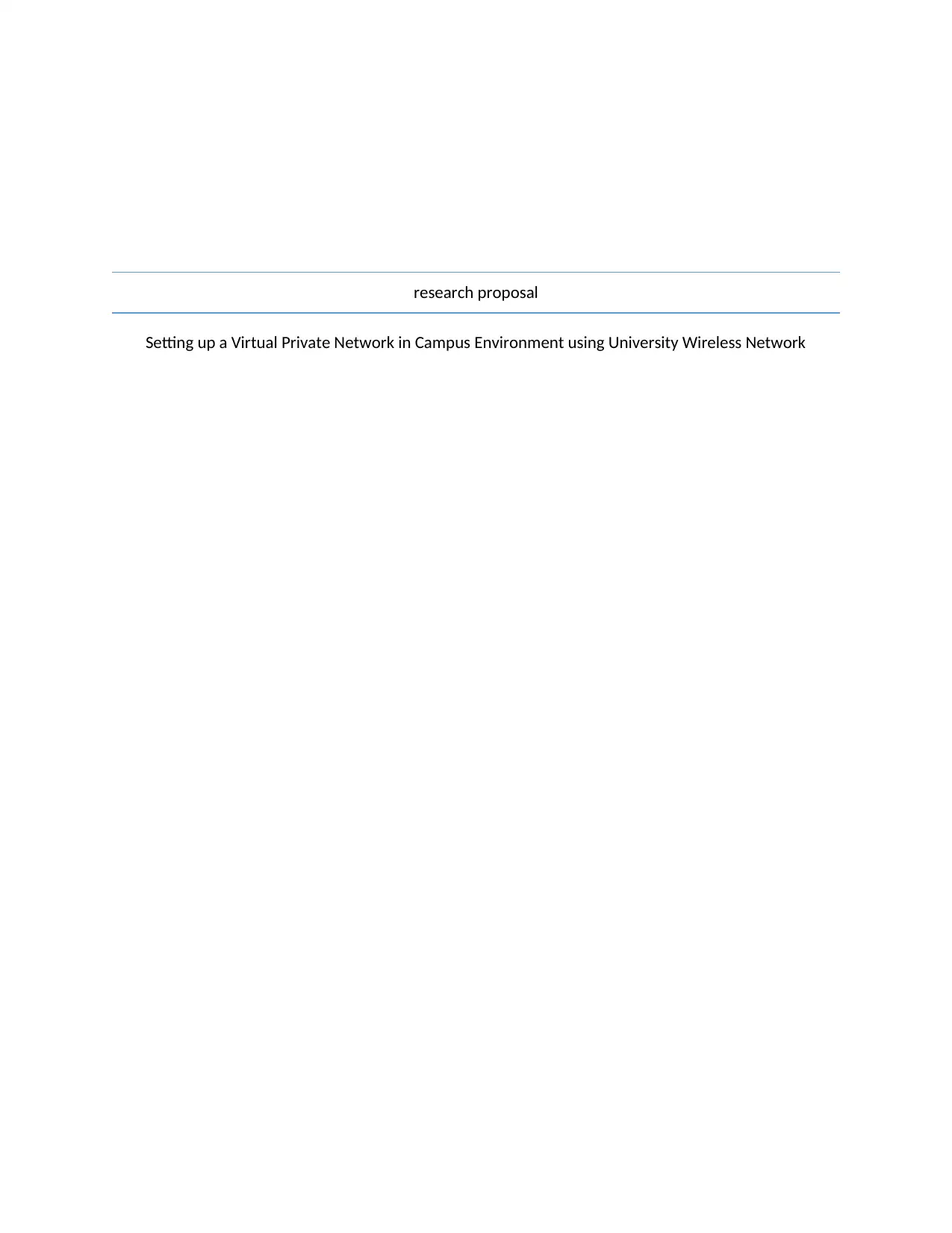
research proposal
Setting up a Virtual Private Network in Campus Environment using University Wireless Network
Setting up a Virtual Private Network in Campus Environment using University Wireless Network
Paraphrase This Document
Need a fresh take? Get an instant paraphrase of this document with our AI Paraphraser
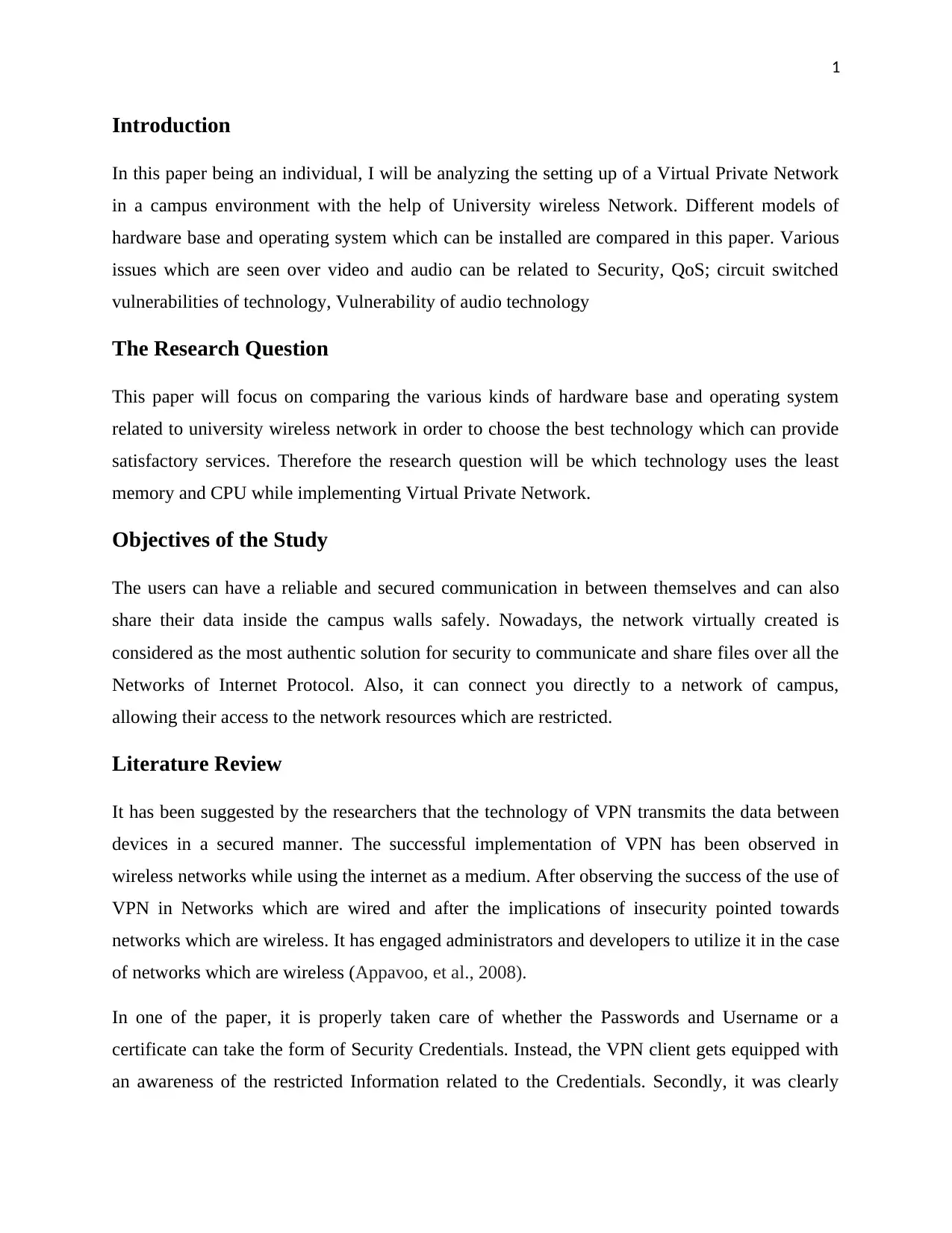
1
Introduction
In this paper being an individual, I will be analyzing the setting up of a Virtual Private Network
in a campus environment with the help of University wireless Network. Different models of
hardware base and operating system which can be installed are compared in this paper. Various
issues which are seen over video and audio can be related to Security, QoS; circuit switched
vulnerabilities of technology, Vulnerability of audio technology
The Research Question
This paper will focus on comparing the various kinds of hardware base and operating system
related to university wireless network in order to choose the best technology which can provide
satisfactory services. Therefore the research question will be which technology uses the least
memory and CPU while implementing Virtual Private Network.
Objectives of the Study
The users can have a reliable and secured communication in between themselves and can also
share their data inside the campus walls safely. Nowadays, the network virtually created is
considered as the most authentic solution for security to communicate and share files over all the
Networks of Internet Protocol. Also, it can connect you directly to a network of campus,
allowing their access to the network resources which are restricted.
Literature Review
It has been suggested by the researchers that the technology of VPN transmits the data between
devices in a secured manner. The successful implementation of VPN has been observed in
wireless networks while using the internet as a medium. After observing the success of the use of
VPN in Networks which are wired and after the implications of insecurity pointed towards
networks which are wireless. It has engaged administrators and developers to utilize it in the case
of networks which are wireless (Appavoo, et al., 2008).
In one of the paper, it is properly taken care of whether the Passwords and Username or a
certificate can take the form of Security Credentials. Instead, the VPN client gets equipped with
an awareness of the restricted Information related to the Credentials. Secondly, it was clearly
Introduction
In this paper being an individual, I will be analyzing the setting up of a Virtual Private Network
in a campus environment with the help of University wireless Network. Different models of
hardware base and operating system which can be installed are compared in this paper. Various
issues which are seen over video and audio can be related to Security, QoS; circuit switched
vulnerabilities of technology, Vulnerability of audio technology
The Research Question
This paper will focus on comparing the various kinds of hardware base and operating system
related to university wireless network in order to choose the best technology which can provide
satisfactory services. Therefore the research question will be which technology uses the least
memory and CPU while implementing Virtual Private Network.
Objectives of the Study
The users can have a reliable and secured communication in between themselves and can also
share their data inside the campus walls safely. Nowadays, the network virtually created is
considered as the most authentic solution for security to communicate and share files over all the
Networks of Internet Protocol. Also, it can connect you directly to a network of campus,
allowing their access to the network resources which are restricted.
Literature Review
It has been suggested by the researchers that the technology of VPN transmits the data between
devices in a secured manner. The successful implementation of VPN has been observed in
wireless networks while using the internet as a medium. After observing the success of the use of
VPN in Networks which are wired and after the implications of insecurity pointed towards
networks which are wireless. It has engaged administrators and developers to utilize it in the case
of networks which are wireless (Appavoo, et al., 2008).
In one of the paper, it is properly taken care of whether the Passwords and Username or a
certificate can take the form of Security Credentials. Instead, the VPN client gets equipped with
an awareness of the restricted Information related to the Credentials. Secondly, it was clearly
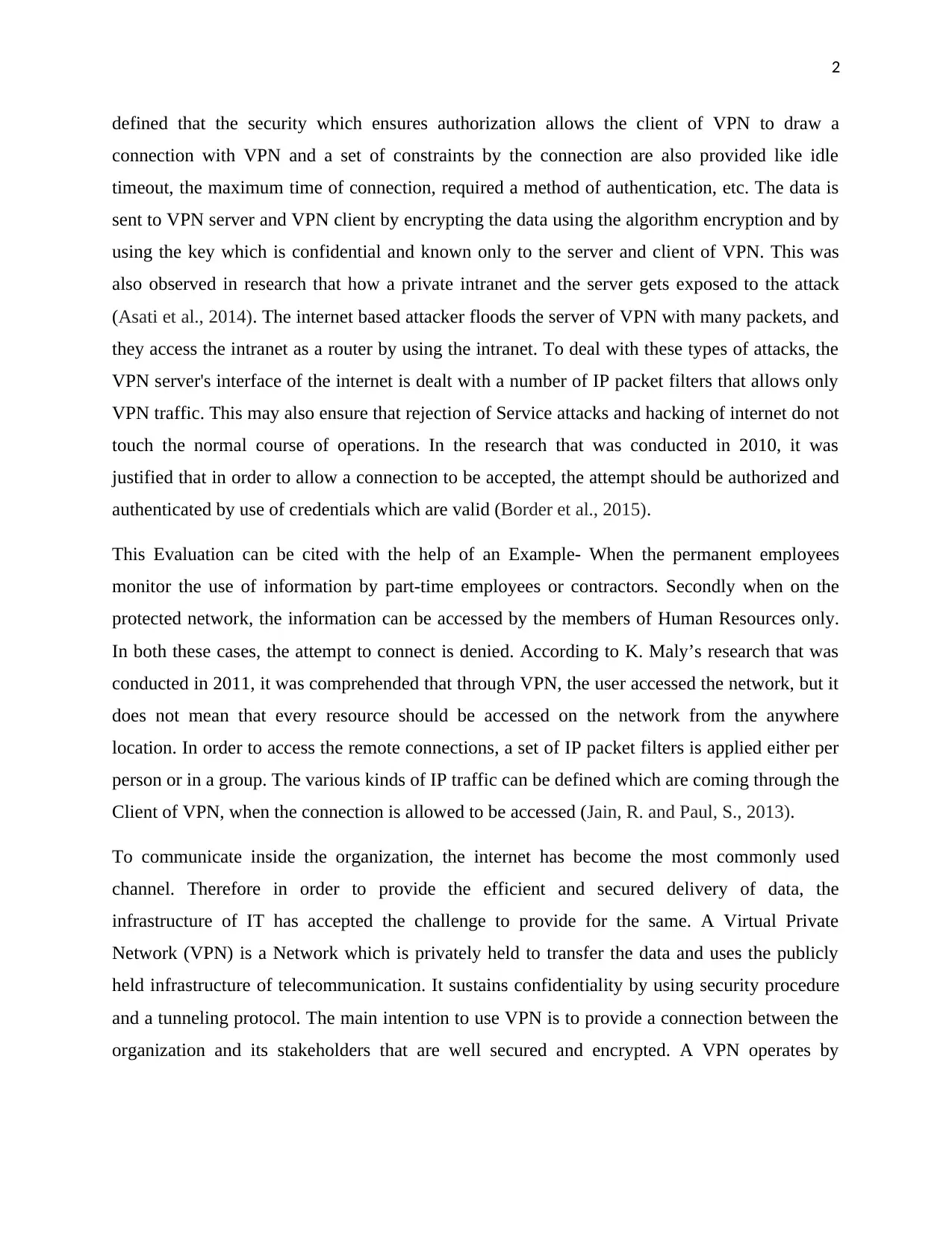
2
defined that the security which ensures authorization allows the client of VPN to draw a
connection with VPN and a set of constraints by the connection are also provided like idle
timeout, the maximum time of connection, required a method of authentication, etc. The data is
sent to VPN server and VPN client by encrypting the data using the algorithm encryption and by
using the key which is confidential and known only to the server and client of VPN. This was
also observed in research that how a private intranet and the server gets exposed to the attack
(Asati et al., 2014). The internet based attacker floods the server of VPN with many packets, and
they access the intranet as a router by using the intranet. To deal with these types of attacks, the
VPN server's interface of the internet is dealt with a number of IP packet filters that allows only
VPN traffic. This may also ensure that rejection of Service attacks and hacking of internet do not
touch the normal course of operations. In the research that was conducted in 2010, it was
justified that in order to allow a connection to be accepted, the attempt should be authorized and
authenticated by use of credentials which are valid (Border et al., 2015).
This Evaluation can be cited with the help of an Example- When the permanent employees
monitor the use of information by part-time employees or contractors. Secondly when on the
protected network, the information can be accessed by the members of Human Resources only.
In both these cases, the attempt to connect is denied. According to K. Maly’s research that was
conducted in 2011, it was comprehended that through VPN, the user accessed the network, but it
does not mean that every resource should be accessed on the network from the anywhere
location. In order to access the remote connections, a set of IP packet filters is applied either per
person or in a group. The various kinds of IP traffic can be defined which are coming through the
Client of VPN, when the connection is allowed to be accessed (Jain, R. and Paul, S., 2013).
To communicate inside the organization, the internet has become the most commonly used
channel. Therefore in order to provide the efficient and secured delivery of data, the
infrastructure of IT has accepted the challenge to provide for the same. A Virtual Private
Network (VPN) is a Network which is privately held to transfer the data and uses the publicly
held infrastructure of telecommunication. It sustains confidentiality by using security procedure
and a tunneling protocol. The main intention to use VPN is to provide a connection between the
organization and its stakeholders that are well secured and encrypted. A VPN operates by
defined that the security which ensures authorization allows the client of VPN to draw a
connection with VPN and a set of constraints by the connection are also provided like idle
timeout, the maximum time of connection, required a method of authentication, etc. The data is
sent to VPN server and VPN client by encrypting the data using the algorithm encryption and by
using the key which is confidential and known only to the server and client of VPN. This was
also observed in research that how a private intranet and the server gets exposed to the attack
(Asati et al., 2014). The internet based attacker floods the server of VPN with many packets, and
they access the intranet as a router by using the intranet. To deal with these types of attacks, the
VPN server's interface of the internet is dealt with a number of IP packet filters that allows only
VPN traffic. This may also ensure that rejection of Service attacks and hacking of internet do not
touch the normal course of operations. In the research that was conducted in 2010, it was
justified that in order to allow a connection to be accepted, the attempt should be authorized and
authenticated by use of credentials which are valid (Border et al., 2015).
This Evaluation can be cited with the help of an Example- When the permanent employees
monitor the use of information by part-time employees or contractors. Secondly when on the
protected network, the information can be accessed by the members of Human Resources only.
In both these cases, the attempt to connect is denied. According to K. Maly’s research that was
conducted in 2011, it was comprehended that through VPN, the user accessed the network, but it
does not mean that every resource should be accessed on the network from the anywhere
location. In order to access the remote connections, a set of IP packet filters is applied either per
person or in a group. The various kinds of IP traffic can be defined which are coming through the
Client of VPN, when the connection is allowed to be accessed (Jain, R. and Paul, S., 2013).
To communicate inside the organization, the internet has become the most commonly used
channel. Therefore in order to provide the efficient and secured delivery of data, the
infrastructure of IT has accepted the challenge to provide for the same. A Virtual Private
Network (VPN) is a Network which is privately held to transfer the data and uses the publicly
held infrastructure of telecommunication. It sustains confidentiality by using security procedure
and a tunneling protocol. The main intention to use VPN is to provide a connection between the
organization and its stakeholders that are well secured and encrypted. A VPN operates by
⊘ This is a preview!⊘
Do you want full access?
Subscribe today to unlock all pages.

Trusted by 1+ million students worldwide

3
transmitting data to the internet via “Tunnels” which are encrypted and secured. The different
kinds of protocols which are used by VPN for tunneling are (Mullick et al., 2013):
Internet Protocol Security (IPSEC): IPsec authenticates users, data integrity and encryption
of data during the transmission of data between receivers and senders. Three protocols which
are primary in nature are used: Internet Key Exchange (IKE), Encapsulated Security Payload
(ESP), and Authentication Header. These are used to transmit data and establish a connection
in a secured way.
Layer2 Tunneling Protocol (L2TP): L2TP tunneling is achieved through encapsulating at
multiple levels. An L2TP header and a PPP header gets encapsulated with PPP data. A UDP
header encapsulates an L2TP.
Point to point tunneling Protocol (PPTP): PPTP is an OSI Layer2 protocol which is an
extension of point-to-point protocol (PPP). An IP datagram is created by it which contains
PPP packets being encrypted and transported via the tunnel.
Secure Sockets Layer (SSL): A seamless connections is committed and given to users with
web browsers while using SSL. The data is protected by getting encrypted and using the hash
to ensure integrity.
To use VPN technology, one can use the tunnel or end to end connection, in
place of putting in use the WEP key to encrypt the data ( Shokhor, S., and Shigapov,
A., F5 Networks, Inc., 2013).
Figure 1 Access Point with VPN Pass-through
transmitting data to the internet via “Tunnels” which are encrypted and secured. The different
kinds of protocols which are used by VPN for tunneling are (Mullick et al., 2013):
Internet Protocol Security (IPSEC): IPsec authenticates users, data integrity and encryption
of data during the transmission of data between receivers and senders. Three protocols which
are primary in nature are used: Internet Key Exchange (IKE), Encapsulated Security Payload
(ESP), and Authentication Header. These are used to transmit data and establish a connection
in a secured way.
Layer2 Tunneling Protocol (L2TP): L2TP tunneling is achieved through encapsulating at
multiple levels. An L2TP header and a PPP header gets encapsulated with PPP data. A UDP
header encapsulates an L2TP.
Point to point tunneling Protocol (PPTP): PPTP is an OSI Layer2 protocol which is an
extension of point-to-point protocol (PPP). An IP datagram is created by it which contains
PPP packets being encrypted and transported via the tunnel.
Secure Sockets Layer (SSL): A seamless connections is committed and given to users with
web browsers while using SSL. The data is protected by getting encrypted and using the hash
to ensure integrity.
To use VPN technology, one can use the tunnel or end to end connection, in
place of putting in use the WEP key to encrypt the data ( Shokhor, S., and Shigapov,
A., F5 Networks, Inc., 2013).
Figure 1 Access Point with VPN Pass-through
Paraphrase This Document
Need a fresh take? Get an instant paraphrase of this document with our AI Paraphraser
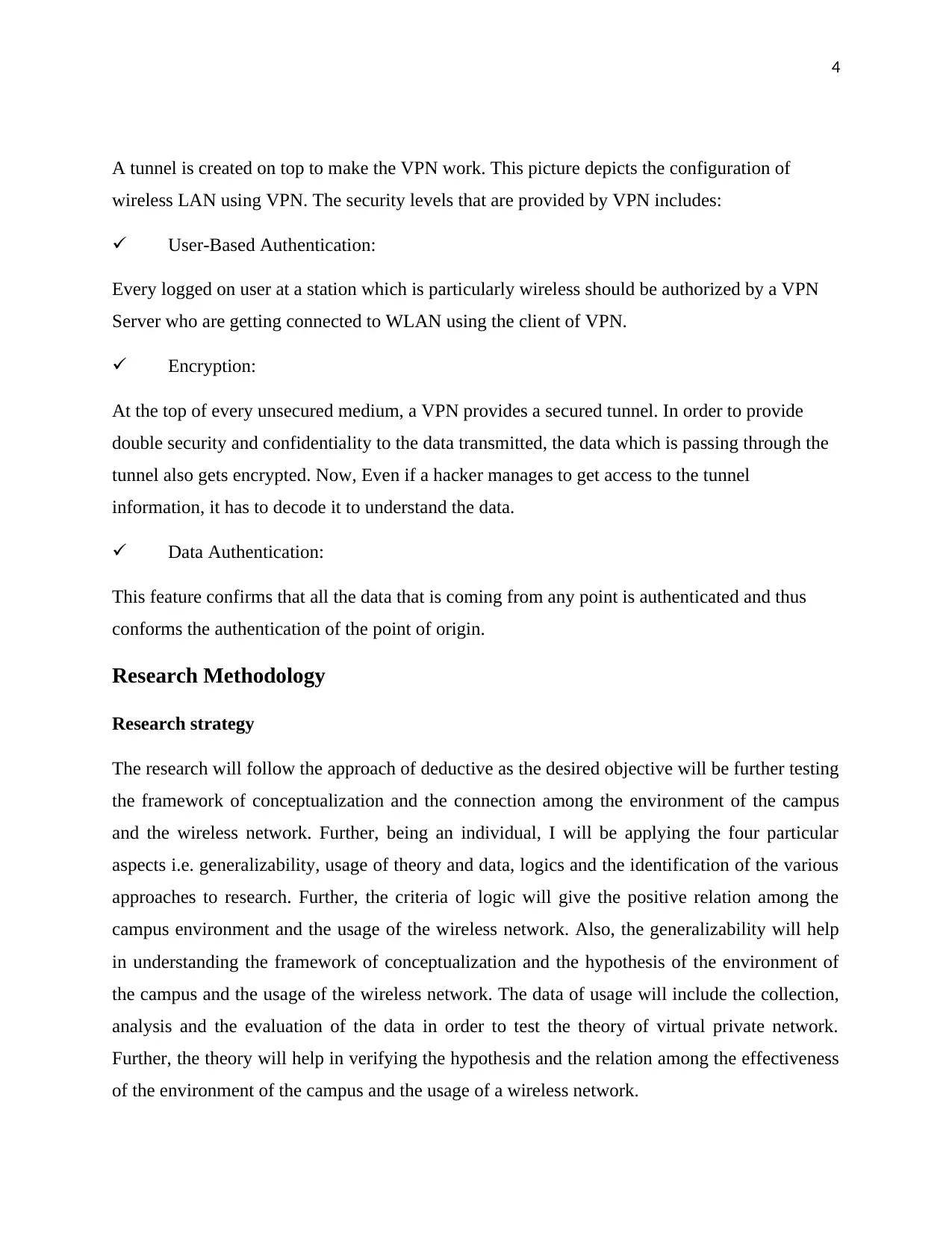
4
A tunnel is created on top to make the VPN work. This picture depicts the configuration of
wireless LAN using VPN. The security levels that are provided by VPN includes:
User-Based Authentication:
Every logged on user at a station which is particularly wireless should be authorized by a VPN
Server who are getting connected to WLAN using the client of VPN.
Encryption:
At the top of every unsecured medium, a VPN provides a secured tunnel. In order to provide
double security and confidentiality to the data transmitted, the data which is passing through the
tunnel also gets encrypted. Now, Even if a hacker manages to get access to the tunnel
information, it has to decode it to understand the data.
Data Authentication:
This feature confirms that all the data that is coming from any point is authenticated and thus
conforms the authentication of the point of origin.
Research Methodology
Research strategy
The research will follow the approach of deductive as the desired objective will be further testing
the framework of conceptualization and the connection among the environment of the campus
and the wireless network. Further, being an individual, I will be applying the four particular
aspects i.e. generalizability, usage of theory and data, logics and the identification of the various
approaches to research. Further, the criteria of logic will give the positive relation among the
campus environment and the usage of the wireless network. Also, the generalizability will help
in understanding the framework of conceptualization and the hypothesis of the environment of
the campus and the usage of the wireless network. The data of usage will include the collection,
analysis and the evaluation of the data in order to test the theory of virtual private network.
Further, the theory will help in verifying the hypothesis and the relation among the effectiveness
of the environment of the campus and the usage of a wireless network.
A tunnel is created on top to make the VPN work. This picture depicts the configuration of
wireless LAN using VPN. The security levels that are provided by VPN includes:
User-Based Authentication:
Every logged on user at a station which is particularly wireless should be authorized by a VPN
Server who are getting connected to WLAN using the client of VPN.
Encryption:
At the top of every unsecured medium, a VPN provides a secured tunnel. In order to provide
double security and confidentiality to the data transmitted, the data which is passing through the
tunnel also gets encrypted. Now, Even if a hacker manages to get access to the tunnel
information, it has to decode it to understand the data.
Data Authentication:
This feature confirms that all the data that is coming from any point is authenticated and thus
conforms the authentication of the point of origin.
Research Methodology
Research strategy
The research will follow the approach of deductive as the desired objective will be further testing
the framework of conceptualization and the connection among the environment of the campus
and the wireless network. Further, being an individual, I will be applying the four particular
aspects i.e. generalizability, usage of theory and data, logics and the identification of the various
approaches to research. Further, the criteria of logic will give the positive relation among the
campus environment and the usage of the wireless network. Also, the generalizability will help
in understanding the framework of conceptualization and the hypothesis of the environment of
the campus and the usage of the wireless network. The data of usage will include the collection,
analysis and the evaluation of the data in order to test the theory of virtual private network.
Further, the theory will help in verifying the hypothesis and the relation among the effectiveness
of the environment of the campus and the usage of a wireless network.
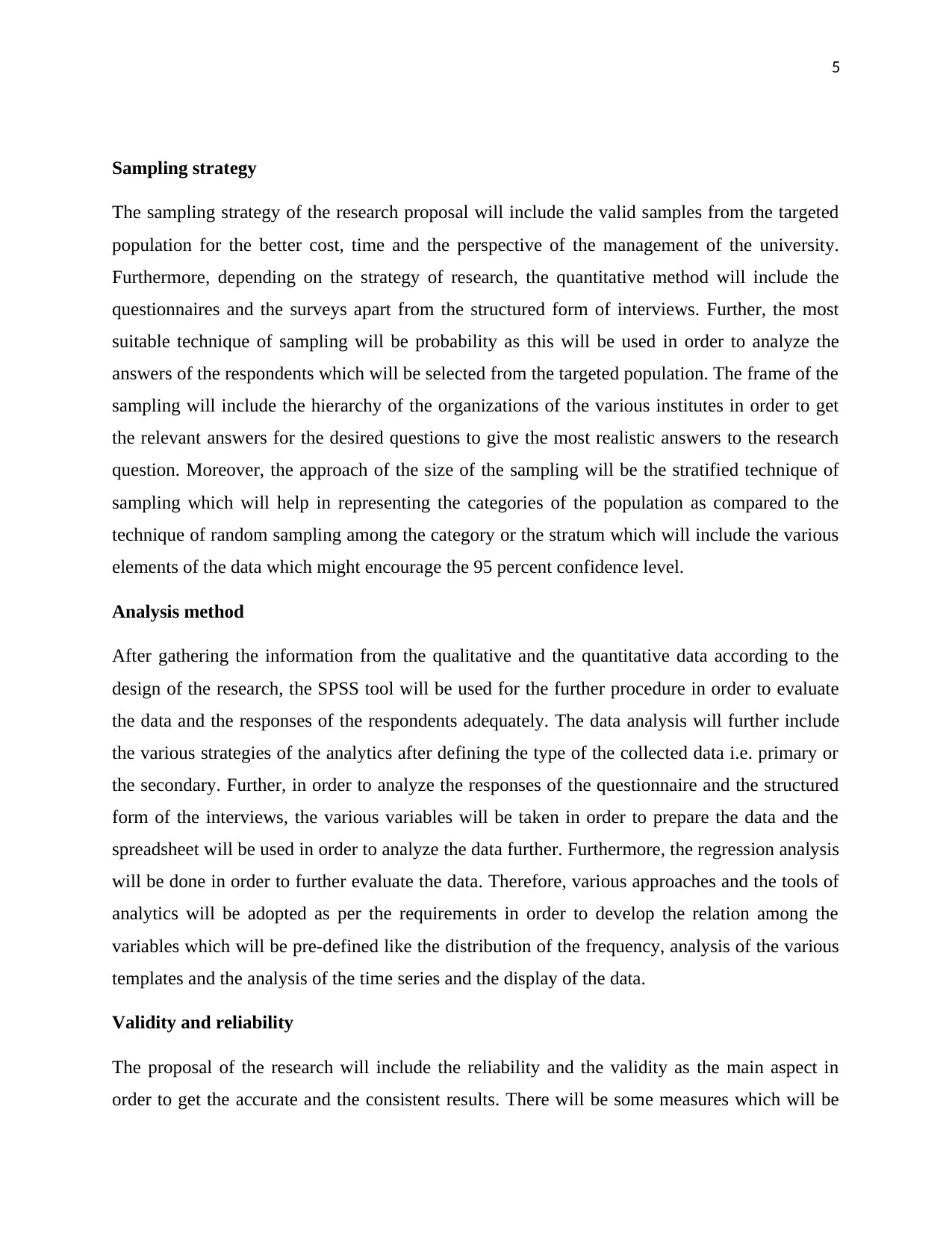
5
Sampling strategy
The sampling strategy of the research proposal will include the valid samples from the targeted
population for the better cost, time and the perspective of the management of the university.
Furthermore, depending on the strategy of research, the quantitative method will include the
questionnaires and the surveys apart from the structured form of interviews. Further, the most
suitable technique of sampling will be probability as this will be used in order to analyze the
answers of the respondents which will be selected from the targeted population. The frame of the
sampling will include the hierarchy of the organizations of the various institutes in order to get
the relevant answers for the desired questions to give the most realistic answers to the research
question. Moreover, the approach of the size of the sampling will be the stratified technique of
sampling which will help in representing the categories of the population as compared to the
technique of random sampling among the category or the stratum which will include the various
elements of the data which might encourage the 95 percent confidence level.
Analysis method
After gathering the information from the qualitative and the quantitative data according to the
design of the research, the SPSS tool will be used for the further procedure in order to evaluate
the data and the responses of the respondents adequately. The data analysis will further include
the various strategies of the analytics after defining the type of the collected data i.e. primary or
the secondary. Further, in order to analyze the responses of the questionnaire and the structured
form of the interviews, the various variables will be taken in order to prepare the data and the
spreadsheet will be used in order to analyze the data further. Furthermore, the regression analysis
will be done in order to further evaluate the data. Therefore, various approaches and the tools of
analytics will be adopted as per the requirements in order to develop the relation among the
variables which will be pre-defined like the distribution of the frequency, analysis of the various
templates and the analysis of the time series and the display of the data.
Validity and reliability
The proposal of the research will include the reliability and the validity as the main aspect in
order to get the accurate and the consistent results. There will be some measures which will be
Sampling strategy
The sampling strategy of the research proposal will include the valid samples from the targeted
population for the better cost, time and the perspective of the management of the university.
Furthermore, depending on the strategy of research, the quantitative method will include the
questionnaires and the surveys apart from the structured form of interviews. Further, the most
suitable technique of sampling will be probability as this will be used in order to analyze the
answers of the respondents which will be selected from the targeted population. The frame of the
sampling will include the hierarchy of the organizations of the various institutes in order to get
the relevant answers for the desired questions to give the most realistic answers to the research
question. Moreover, the approach of the size of the sampling will be the stratified technique of
sampling which will help in representing the categories of the population as compared to the
technique of random sampling among the category or the stratum which will include the various
elements of the data which might encourage the 95 percent confidence level.
Analysis method
After gathering the information from the qualitative and the quantitative data according to the
design of the research, the SPSS tool will be used for the further procedure in order to evaluate
the data and the responses of the respondents adequately. The data analysis will further include
the various strategies of the analytics after defining the type of the collected data i.e. primary or
the secondary. Further, in order to analyze the responses of the questionnaire and the structured
form of the interviews, the various variables will be taken in order to prepare the data and the
spreadsheet will be used in order to analyze the data further. Furthermore, the regression analysis
will be done in order to further evaluate the data. Therefore, various approaches and the tools of
analytics will be adopted as per the requirements in order to develop the relation among the
variables which will be pre-defined like the distribution of the frequency, analysis of the various
templates and the analysis of the time series and the display of the data.
Validity and reliability
The proposal of the research will include the reliability and the validity as the main aspect in
order to get the accurate and the consistent results. There will be some measures which will be
⊘ This is a preview!⊘
Do you want full access?
Subscribe today to unlock all pages.

Trusted by 1+ million students worldwide
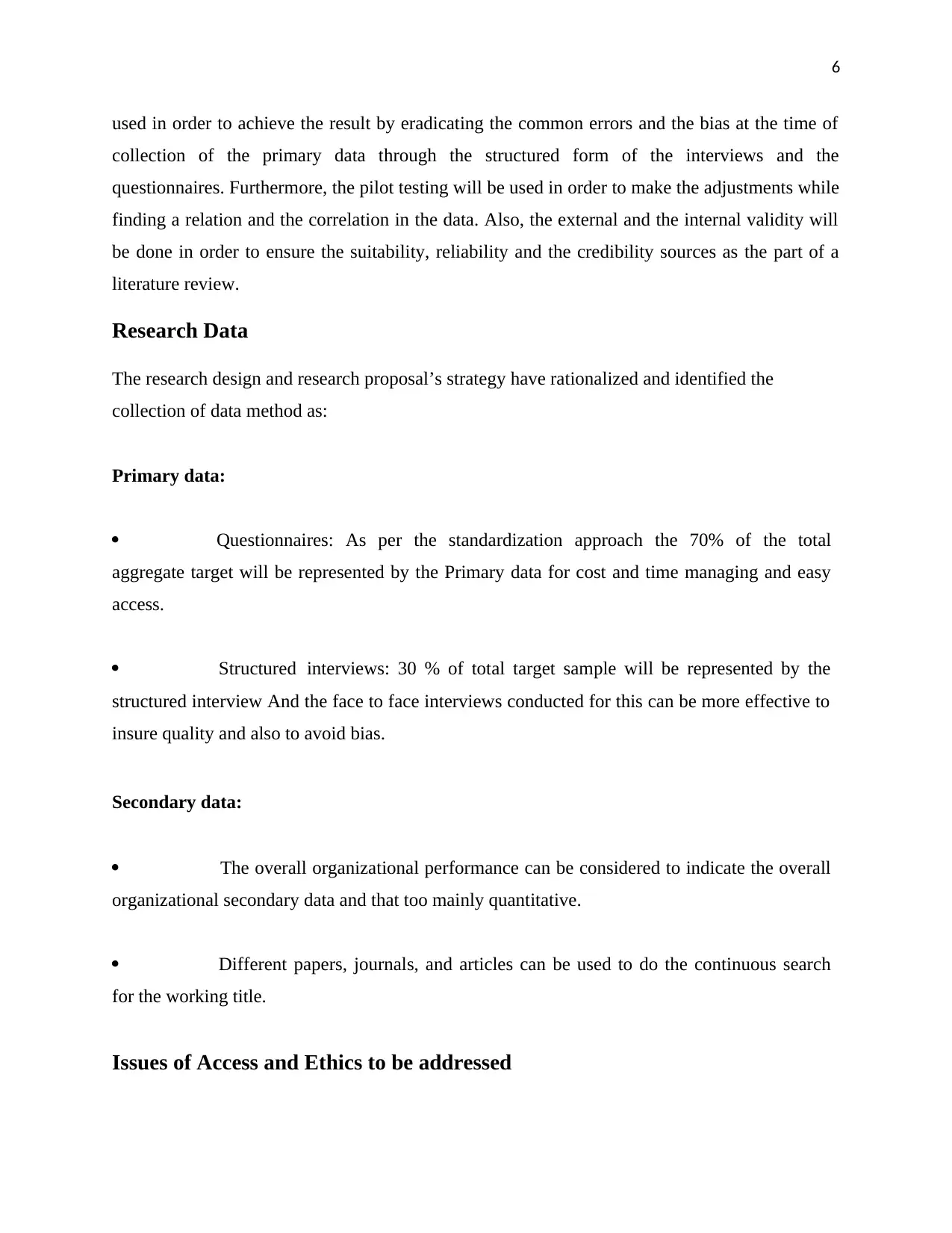
6
used in order to achieve the result by eradicating the common errors and the bias at the time of
collection of the primary data through the structured form of the interviews and the
questionnaires. Furthermore, the pilot testing will be used in order to make the adjustments while
finding a relation and the correlation in the data. Also, the external and the internal validity will
be done in order to ensure the suitability, reliability and the credibility sources as the part of a
literature review.
Research Data
The research design and research proposal’s strategy have rationalized and identified the
collection of data method as:
Primary data:
Questionnaires: As per the standardization approach the 70% of the total
aggregate target will be represented by the Primary data for cost and time managing and easy
access.
Structured interviews: 30 % of total target sample will be represented by the
structured interview And the face to face interviews conducted for this can be more effective to
insure quality and also to avoid bias.
Secondary data:
The overall organizational performance can be considered to indicate the overall
organizational secondary data and that too mainly quantitative.
Different papers, journals, and articles can be used to do the continuous search
for the working title.
Issues of Access and Ethics to be addressed
used in order to achieve the result by eradicating the common errors and the bias at the time of
collection of the primary data through the structured form of the interviews and the
questionnaires. Furthermore, the pilot testing will be used in order to make the adjustments while
finding a relation and the correlation in the data. Also, the external and the internal validity will
be done in order to ensure the suitability, reliability and the credibility sources as the part of a
literature review.
Research Data
The research design and research proposal’s strategy have rationalized and identified the
collection of data method as:
Primary data:
Questionnaires: As per the standardization approach the 70% of the total
aggregate target will be represented by the Primary data for cost and time managing and easy
access.
Structured interviews: 30 % of total target sample will be represented by the
structured interview And the face to face interviews conducted for this can be more effective to
insure quality and also to avoid bias.
Secondary data:
The overall organizational performance can be considered to indicate the overall
organizational secondary data and that too mainly quantitative.
Different papers, journals, and articles can be used to do the continuous search
for the working title.
Issues of Access and Ethics to be addressed
Paraphrase This Document
Need a fresh take? Get an instant paraphrase of this document with our AI Paraphraser
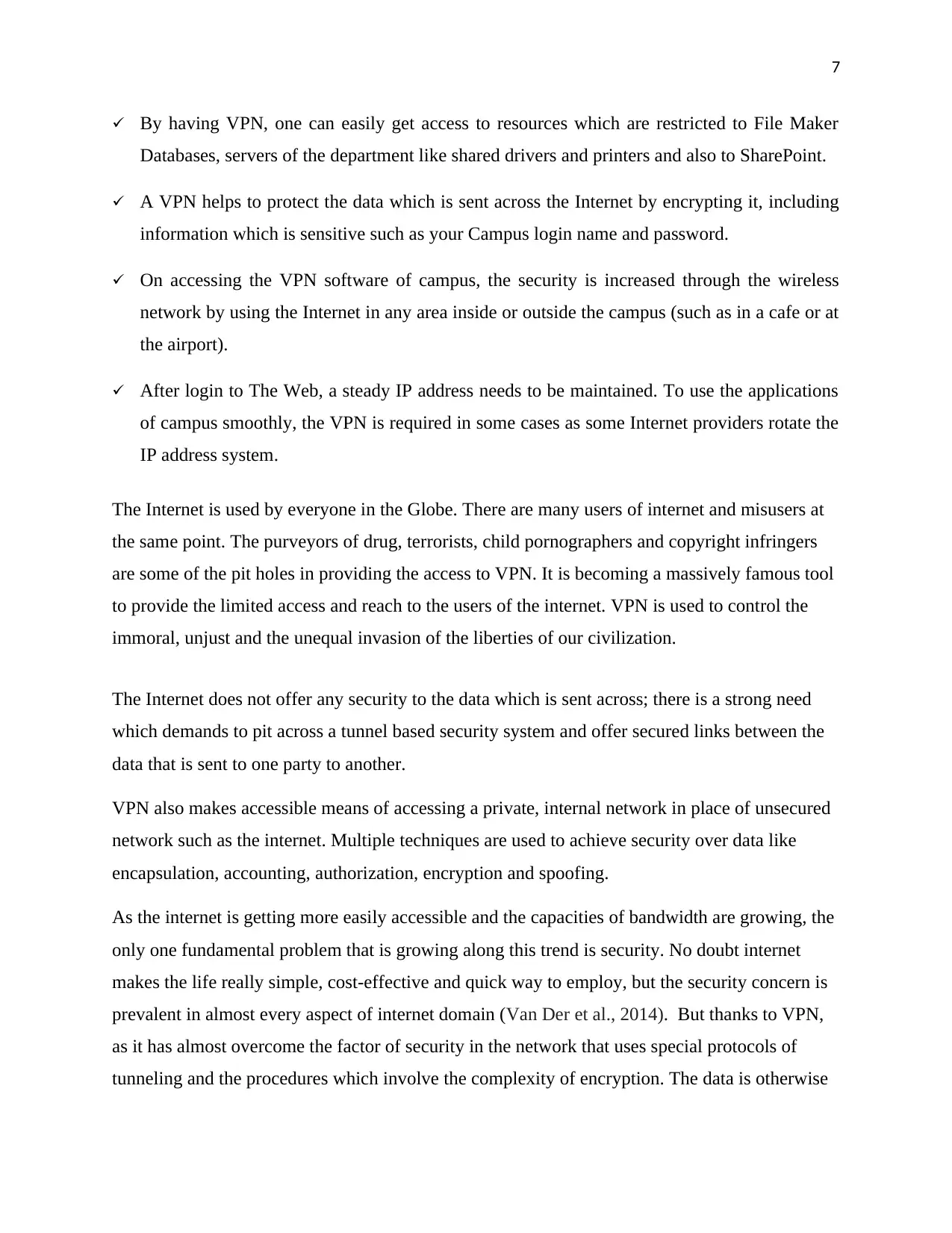
7
By having VPN, one can easily get access to resources which are restricted to File Maker
Databases, servers of the department like shared drivers and printers and also to SharePoint.
A VPN helps to protect the data which is sent across the Internet by encrypting it, including
information which is sensitive such as your Campus login name and password.
On accessing the VPN software of campus, the security is increased through the wireless
network by using the Internet in any area inside or outside the campus (such as in a cafe or at
the airport).
After login to The Web, a steady IP address needs to be maintained. To use the applications
of campus smoothly, the VPN is required in some cases as some Internet providers rotate the
IP address system.
The Internet is used by everyone in the Globe. There are many users of internet and misusers at
the same point. The purveyors of drug, terrorists, child pornographers and copyright infringers
are some of the pit holes in providing the access to VPN. It is becoming a massively famous tool
to provide the limited access and reach to the users of the internet. VPN is used to control the
immoral, unjust and the unequal invasion of the liberties of our civilization.
The Internet does not offer any security to the data which is sent across; there is a strong need
which demands to pit across a tunnel based security system and offer secured links between the
data that is sent to one party to another.
VPN also makes accessible means of accessing a private, internal network in place of unsecured
network such as the internet. Multiple techniques are used to achieve security over data like
encapsulation, accounting, authorization, encryption and spoofing.
As the internet is getting more easily accessible and the capacities of bandwidth are growing, the
only one fundamental problem that is growing along this trend is security. No doubt internet
makes the life really simple, cost-effective and quick way to employ, but the security concern is
prevalent in almost every aspect of internet domain (Van Der et al., 2014). But thanks to VPN,
as it has almost overcome the factor of security in the network that uses special protocols of
tunneling and the procedures which involve the complexity of encryption. The data is otherwise
By having VPN, one can easily get access to resources which are restricted to File Maker
Databases, servers of the department like shared drivers and printers and also to SharePoint.
A VPN helps to protect the data which is sent across the Internet by encrypting it, including
information which is sensitive such as your Campus login name and password.
On accessing the VPN software of campus, the security is increased through the wireless
network by using the Internet in any area inside or outside the campus (such as in a cafe or at
the airport).
After login to The Web, a steady IP address needs to be maintained. To use the applications
of campus smoothly, the VPN is required in some cases as some Internet providers rotate the
IP address system.
The Internet is used by everyone in the Globe. There are many users of internet and misusers at
the same point. The purveyors of drug, terrorists, child pornographers and copyright infringers
are some of the pit holes in providing the access to VPN. It is becoming a massively famous tool
to provide the limited access and reach to the users of the internet. VPN is used to control the
immoral, unjust and the unequal invasion of the liberties of our civilization.
The Internet does not offer any security to the data which is sent across; there is a strong need
which demands to pit across a tunnel based security system and offer secured links between the
data that is sent to one party to another.
VPN also makes accessible means of accessing a private, internal network in place of unsecured
network such as the internet. Multiple techniques are used to achieve security over data like
encapsulation, accounting, authorization, encryption and spoofing.
As the internet is getting more easily accessible and the capacities of bandwidth are growing, the
only one fundamental problem that is growing along this trend is security. No doubt internet
makes the life really simple, cost-effective and quick way to employ, but the security concern is
prevalent in almost every aspect of internet domain (Van Der et al., 2014). But thanks to VPN,
as it has almost overcome the factor of security in the network that uses special protocols of
tunneling and the procedures which involve the complexity of encryption. The data is otherwise
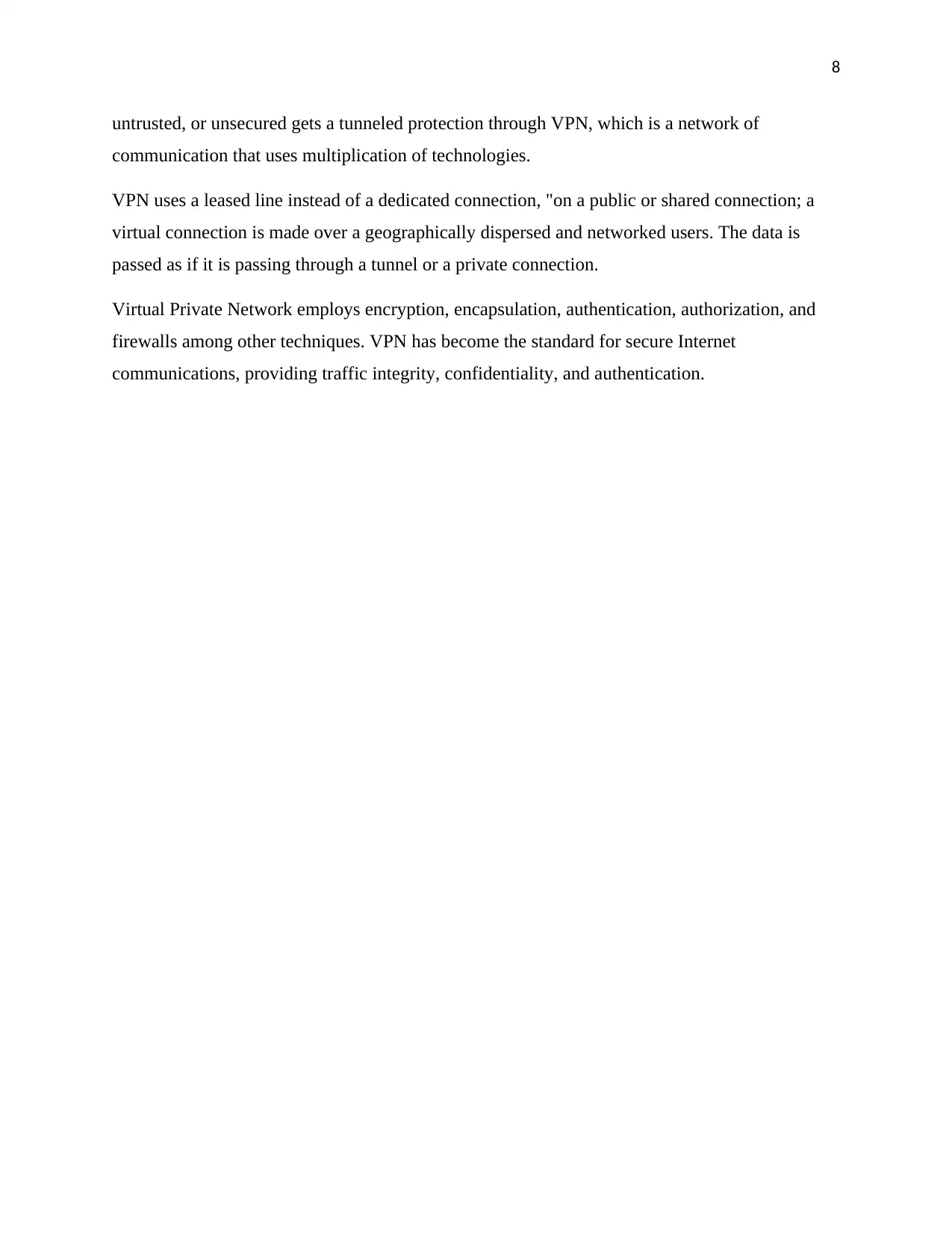
8
untrusted, or unsecured gets a tunneled protection through VPN, which is a network of
communication that uses multiplication of technologies.
VPN uses a leased line instead of a dedicated connection, "on a public or shared connection; a
virtual connection is made over a geographically dispersed and networked users. The data is
passed as if it is passing through a tunnel or a private connection.
Virtual Private Network employs encryption, encapsulation, authentication, authorization, and
firewalls among other techniques. VPN has become the standard for secure Internet
communications, providing traffic integrity, confidentiality, and authentication.
untrusted, or unsecured gets a tunneled protection through VPN, which is a network of
communication that uses multiplication of technologies.
VPN uses a leased line instead of a dedicated connection, "on a public or shared connection; a
virtual connection is made over a geographically dispersed and networked users. The data is
passed as if it is passing through a tunnel or a private connection.
Virtual Private Network employs encryption, encapsulation, authentication, authorization, and
firewalls among other techniques. VPN has become the standard for secure Internet
communications, providing traffic integrity, confidentiality, and authentication.
⊘ This is a preview!⊘
Do you want full access?
Subscribe today to unlock all pages.

Trusted by 1+ million students worldwide
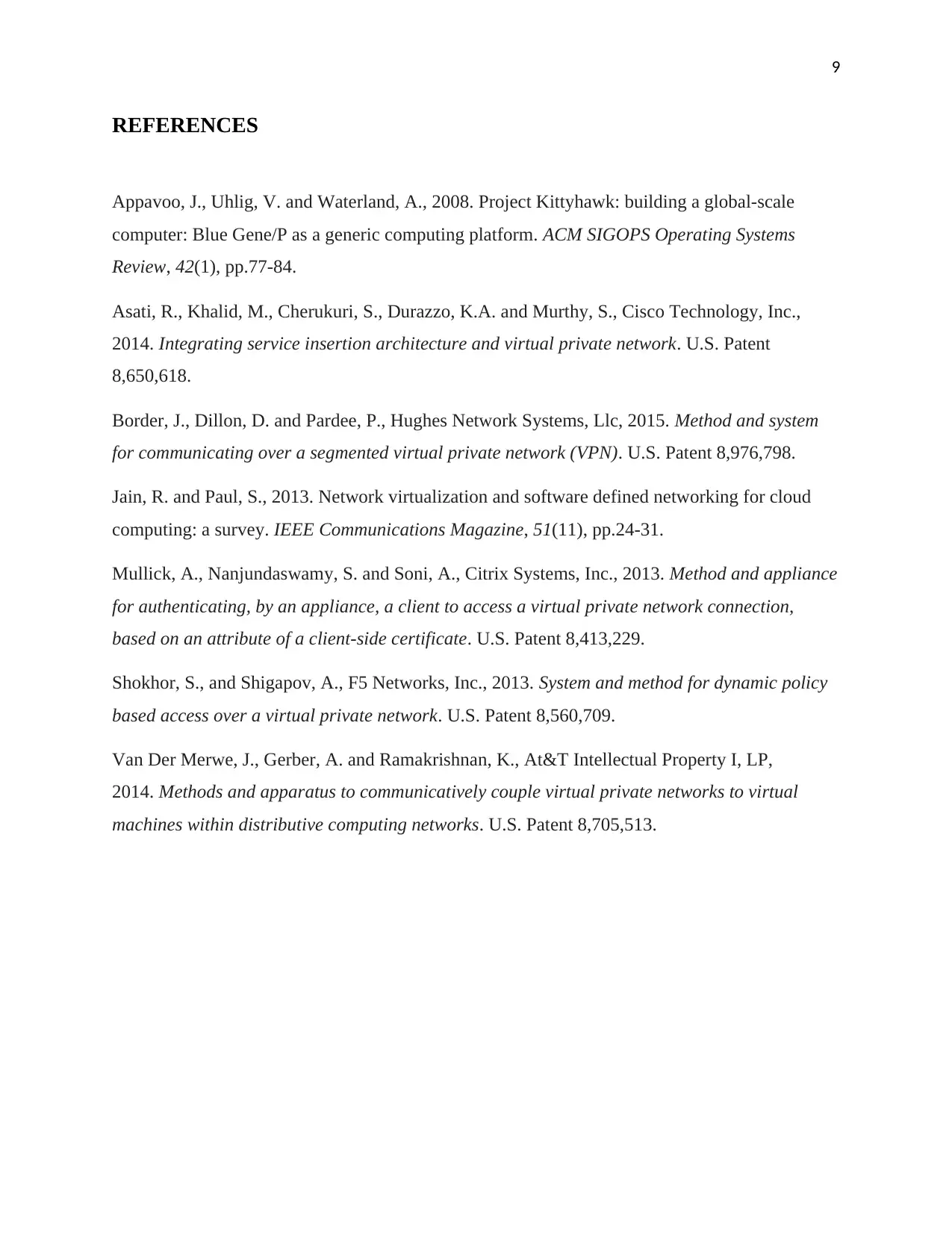
9
REFERENCES
Appavoo, J., Uhlig, V. and Waterland, A., 2008. Project Kittyhawk: building a global-scale
computer: Blue Gene/P as a generic computing platform. ACM SIGOPS Operating Systems
Review, 42(1), pp.77-84.
Asati, R., Khalid, M., Cherukuri, S., Durazzo, K.A. and Murthy, S., Cisco Technology, Inc.,
2014. Integrating service insertion architecture and virtual private network. U.S. Patent
8,650,618.
Border, J., Dillon, D. and Pardee, P., Hughes Network Systems, Llc, 2015. Method and system
for communicating over a segmented virtual private network (VPN). U.S. Patent 8,976,798.
Jain, R. and Paul, S., 2013. Network virtualization and software defined networking for cloud
computing: a survey. IEEE Communications Magazine, 51(11), pp.24-31.
Mullick, A., Nanjundaswamy, S. and Soni, A., Citrix Systems, Inc., 2013. Method and appliance
for authenticating, by an appliance, a client to access a virtual private network connection,
based on an attribute of a client-side certificate. U.S. Patent 8,413,229.
Shokhor, S., and Shigapov, A., F5 Networks, Inc., 2013. System and method for dynamic policy
based access over a virtual private network. U.S. Patent 8,560,709.
Van Der Merwe, J., Gerber, A. and Ramakrishnan, K., At&T Intellectual Property I, LP,
2014. Methods and apparatus to communicatively couple virtual private networks to virtual
machines within distributive computing networks. U.S. Patent 8,705,513.
REFERENCES
Appavoo, J., Uhlig, V. and Waterland, A., 2008. Project Kittyhawk: building a global-scale
computer: Blue Gene/P as a generic computing platform. ACM SIGOPS Operating Systems
Review, 42(1), pp.77-84.
Asati, R., Khalid, M., Cherukuri, S., Durazzo, K.A. and Murthy, S., Cisco Technology, Inc.,
2014. Integrating service insertion architecture and virtual private network. U.S. Patent
8,650,618.
Border, J., Dillon, D. and Pardee, P., Hughes Network Systems, Llc, 2015. Method and system
for communicating over a segmented virtual private network (VPN). U.S. Patent 8,976,798.
Jain, R. and Paul, S., 2013. Network virtualization and software defined networking for cloud
computing: a survey. IEEE Communications Magazine, 51(11), pp.24-31.
Mullick, A., Nanjundaswamy, S. and Soni, A., Citrix Systems, Inc., 2013. Method and appliance
for authenticating, by an appliance, a client to access a virtual private network connection,
based on an attribute of a client-side certificate. U.S. Patent 8,413,229.
Shokhor, S., and Shigapov, A., F5 Networks, Inc., 2013. System and method for dynamic policy
based access over a virtual private network. U.S. Patent 8,560,709.
Van Der Merwe, J., Gerber, A. and Ramakrishnan, K., At&T Intellectual Property I, LP,
2014. Methods and apparatus to communicatively couple virtual private networks to virtual
machines within distributive computing networks. U.S. Patent 8,705,513.
1 out of 10
Related Documents
Your All-in-One AI-Powered Toolkit for Academic Success.
+13062052269
info@desklib.com
Available 24*7 on WhatsApp / Email
![[object Object]](/_next/static/media/star-bottom.7253800d.svg)
Unlock your academic potential
Copyright © 2020–2025 A2Z Services. All Rights Reserved. Developed and managed by ZUCOL.





